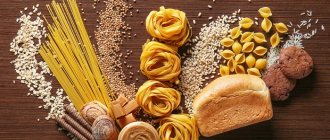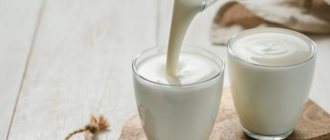The role of glycogen in the body
The ability of athletes to train day after day is largely dependent on adequate replenishment of the body's glycogen stores, a process that requires the consumption of sufficient dietary carbohydrates and adequate rest time. The attempt of beginners to train several times a day and the subsequent feeling of fatigue is also associated with the depletion of glycogen reserves, which provide us with the necessary energy during training.
When planning the training process, it is important to consider not only the training itself, but also a balanced diet and rest. It is also necessary to understand how a particular sport uses energy reserves.
For example, endurance sports (running, cycling, swimming, skiing) burn significant reserves of carbohydrates and require special attention to proper nutrition after training, especially long and intense ones.
Where glycogen accumulates and how to replenish its reserves
Glycogen is predominantly stored in the liver and skeletal muscles. At the same time, these depots (the total volume of accumulated polysaccharides) perform different functions and nourish the body in different ways.
Liver glycogen primarily supplies glucose to the bloodstream during periods of fasting, while that stored in skeletal muscle supplies glucose to muscle fibers during exercise. Consequently, its content in the liver decreases when you do not consume carbohydrates for a long time, and the concentration of polysaccharides in the muscles drops after prolonged and intense training.
Glycogen in the liver is predominantly restored immediately after eating. This process is called direct glycogen synthesis.
With muscles, everything is a little more complicated. Immediately after physical activity, the muscle fibers that were involved in the work are metabolically prepared for rapid glycogenesis (the process of synthesizing polysaccharides from glucose). Simply put, the use of glycogen during exercise triggers glycogen synthesis during the recovery period.
When carbohydrates enter the body with food after training, muscles that have worked to their full capacity begin to intensively absorb glucose from food, filling glycogen depots. This increased sensitivity can last up to 48 hours. This is why it is important to immediately eat something high in carbohydrates after a grueling workout.
Proper nutrition is especially important during multi-day competitions, such as cycling races. If an athlete has at least 6 hours of rest between stages, then consuming carbohydrates at the rate of 1-1.2 g per kilogram of weight per hour will replenish up to 80% of the empty depots by the start of the next segment of the race.
Glycogen
Glycogen is the equivalent of starch, synthesized in the animal body, i.e. it is also a reserve polysaccharide, built from a-glucose residues; Glycogen is also found in the cells of many fungi. In vertebrates, glycogen is stored mainly in the liver and muscles, that is, in places of high metabolic activity, where it serves as an important source of energy.
Its conversion back to glucose is regulated by hormones, mainly insulin (Chapter 9). In its structure, glycogen is very similar to amylopectin (Fig. 3.13), but its chains are even more branched. In cells, glycogen is deposited in the form of tiny granules, which are usually associated with the agranular (smooth) endoplasmic reticulum (Fig. 5.12).
Cellulose . Cellulose is a polymer of β-glucose. Unlike starch and glycogen, this polysaccharide performs a structural function; β-glucose molecules are connected to each other; the -OH group at the 1st carbon atom can come into contact with the -OH group at the 4th atom only if one of molecules will be rotated relative to the other by 180° (Fig. 3.14).
This is due to the fact that the –OH group at the 1st atom is located under the plane of the ring, and the –OH group at the 4th atom is above it. Thus, each subsequent residue in the cellulose molecule is rotated by 180° relative to the previous one. This is what distinguishes cellulose molecules from starch molecules. Cellulose contains about 50% of the carbon found in plants, and in terms of its total mass, cellulose on Earth ranks first among all organic compounds.
Almost all cellulose is supplied by plants, although it is also found in some lower invertebrates and primitive groups of fungi. Such a large amount of cellulose on Earth is due to the fact that all plants have cell walls built from it: on average, 20-40% of the cell wall material is cellulose.
The structure of cellulose molecules makes them perfectly suited for this role. They are long chains - approximately 10,000 glucose residues (Fig. 3.14, A). These chains, in which the glucose residues are connected by β-1,4 bonds, are straight, in contrast to the starch chains, whose α-1,4 bonds make them capable of bending and folding.
From each such chain many -OH groups protrude outward. These groups are directed in all directions and form hydrogen bonds with neighboring chains, which ensures rigid cross-linking of all chains. 60-70 chains are combined with each other into microfibrils, and the latter, in turn, are collected into bundles, i.e., into larger structures called macrofibrils (Fig. 3.14, B).
The tensile strength of this structure is extremely high (some idea of this is given by testing the tensile strength of a material such as cotton, which consists almost entirely of cellulose). In the cell wall, layers of cellulose macrofibrils are immersed in a cementitious matrix consisting of other polysaccharides (see its description in Section 5.10.10), which gives the entire structure even greater strength. Thus, plant cells are covered with a shell consisting of several layers of cellulose.
It protects them from rupture when water enters under the influence of osmotic forces, and it also to some extent determines their shape, since the direction in which the cell can stretch depends on how the cellulose layers are located in the cell wall. As water enters, the cell stretches and pressure increases inside it—the cell becomes turgid. In plants lacking wood, it is the turgescent cells that provide the plant with support. For all their strength, cellulose layers easily allow water and substances dissolved in it to pass through - a property that is very important for actively functioning plant cells.
In addition to being one of the structural components of plant cell walls, cellulose also serves as food for some animals, bacteria and fungi. The enzyme cellulase, which breaks down cellulose into glucose, is relatively rare in nature. Therefore, most animals, including humans, cannot use cellulose, although it is a practically inexhaustible and potentially very valuable source of glucose.
However, in ruminant animals, such as cows, bacteria that digest cellulose live in the intestines as symbionts. The extreme abundance of cellulose in nature and its relatively slow decomposition are important in ecological terms, because they mean that a large amount of carbon remains “locked” in this substance, and yet carbon is absolutely necessary for all living organisms. The industrial importance of cellulose is enormous. It is used to make, in particular, cotton fabrics, paper, paper-based adhesive tape, etc.
Literature. Biology: in 3 vols. T. 1 / D. Taylor, N. Green, W. Stout; edited by R. Soper
AOF | 01/02/2021 16:00:58
Back forward
Signs and Causes of Low Glycogen Levels
A low level of polysaccharides in the body will be expressed in rapid fatigue during physical exercise and mental work. A diet rich in carbohydrates and rest will help solve this problem.
Metabolic diseases also occur - glycogenosis, 1 case per 100-500 thousand newborns. These metabolic disorders are caused by a deficiency of enzymes that affect glycogen synthesis in muscles and liver cells. They manifest themselves in the form of rapid muscle fatigue, cramps during sports, and even myopathy (damage to muscles and nerves).
quiz
1. What best describes the function of glycogen? A. Provides structural support to muscle cells B. a transcription factor that regulates cell differentiation C. Stores glucose in plants D. Buffers blood glucose levels and serves as an easily mobilized source of energy
Answer to question #1
D is correct. Glycogen is the main storage form of glucose in animals and humans. Glycogen is synthesized when blood glucose levels are high and broken down when blood glucose levels are low, making it an important buffer of blood glucose levels. When energy is required by a cell or body, Glycogen serves as a critical source of energy, providing glucose to tissues throughout the body.
2. What is the main hormone that stimulates the breakdown of glycogen? A. glucagon B. Thyroid gland C. insulin D. estrogen
Answer to question No. 2
right. Glucagon, which is produced in response to low blood sugar, stimulates the breakdown of glycogen. Insulin, produced in response to high blood sugar, stimulates glucose uptake and glycogen synthesis.
3. What are the possible fates of glucose-1-phosphate produced by glycogenolysis? A. Conversion to glucose-6-phosphate followed by entry into the glycolytic pathway B. Conversion to glucose-6-phosphate followed by entry into the pentose phosphate pathway C. Conversion to glucose followed by release into the bloodstream D. All of the above
Answer to question number 3
D is correct. In muscle cells, glucose-1-phosphate is converted to glucose-6-phosphate by phosphoglucomutase, after which it can enter the glycolytic or pentose phosphate pathway. In liver cells, glucose-6-phosphate is converted to glucose by glucose-6-phosphatase and released into the bloodstream.
Is it possible to increase glycogen stores and how?
Exercise promotes glycogen storage after exercise. In the muscles involved during exercise, the content of polysaccharides quickly increases during recovery, eventually reaching a higher level than before the start of training (supercompensation effect). Accordingly, regularly exercising people will have higher glycogen reserves in the body than untrained people.
It is important to understand that food in itself does not increase glycogen stores, but only contributes to its faster replenishment. That is why it is important for people who regularly exercise or engage in physical labor to control the sufficient carbohydrate content in their diet.











